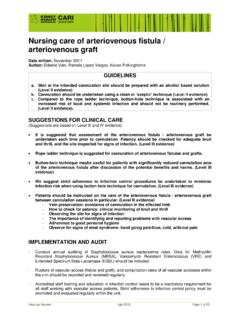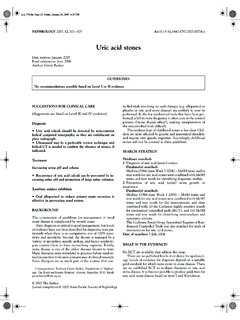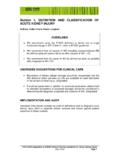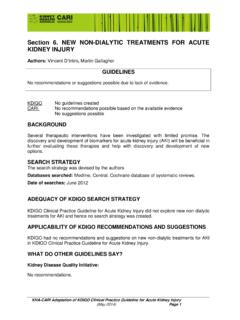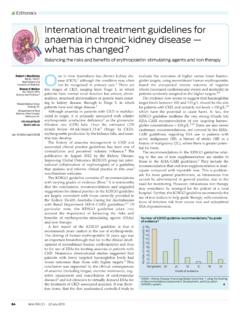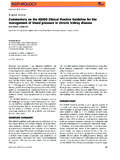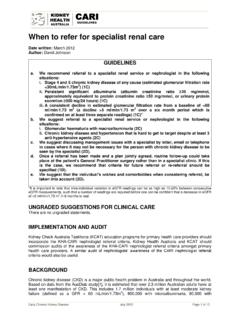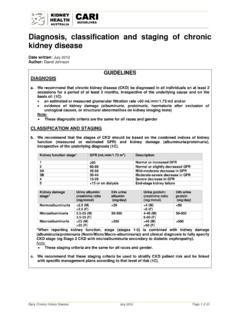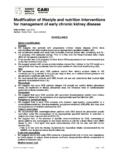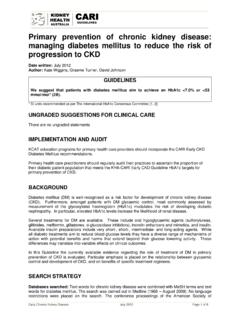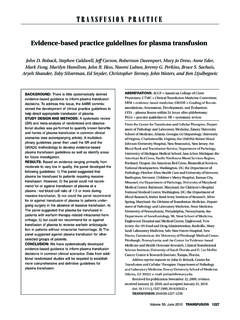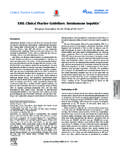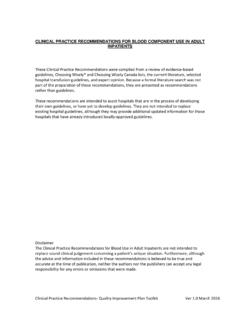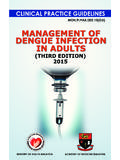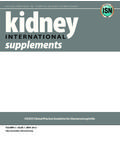Transcription of Editorial Commentary on the KDIGO Clinical Practice ...
1 EditorialCommentary on the KDIGO Clinical Practice Guidelinefor GlomerulonephritisNot so long ago, a paper published inKidney Internationalexplored the reasons for the paucity of high-quality clinicaltrials in glomerulonephritis (GN).1 The authors identifiedseveral factors, including the low prevalence of disease, vari-ability in Clinical presentation, variability in treatmentresponses, lack of consensus about definitions, difficulty inrecruiting patients, the high cost of randomized controlledtrials, and the lack of collaborative research efforts. To thislist, I would also add our poor understanding of the patho-genesis of most if not all of the glomerulonephritides com-monly encountered in Clinical Practice . This point is relevantbecause it limits the variety of new therapies that we can putup for Clinical trials, and ultimately our ability to punchthrough the therapeutic envelope, so to speak.
2 This is not tosay that progress has not been made, but simply that we donot have enough hard data to provide precise advice on allaspects of , there is a need for Clinical Practice serve many purposes, the most important ofwhich is to set down boundaries to define what is reasonableto do, and in so doing, either directly or indirectly, also setdown what is not reasonable to KDIGO Clinical Practice Guideline for Glomerulone-phritis published in 2012 aims to do this and much to present a series of treatment recommendationsand suggestions based on the available evidence for a numberof glomerulonephritides. It also grades the quality of evidencebehind these recommendations. Notably, several conditionsare not covered, such as the management of diabetic neph-ropathy, dysproteinaemias, fibrillary GN and haemolytic-uraemic syndrome. Arguably, these latter conditions are notstrictly inflammatory glomerulonephritides, but nonetheless,they can affect the glomerulus predominantly.
3 In a series ofchapters, each dedicated to a specific GN, a set format is usedto tackle various aspects of Clinical management such asinduction therapy, maintenance therapy, management ofrelapse, and management of resistant disease. At the start ofthese subsections, recommendations and suggestions aremade (annotated Level 1 and 2, respectively), followed bygrading of the quality of evidence behind these recommen-dations (annotated A, B, C and D for high, moderate, low andvery low quality of evidence). A brief background is provided,the rationale for these recommendations/suggestions is dis-cussed, including a summary of the most relevant clinicaltrials, and a number of recommendations are made for futureresearch. The references to publications are listed together inone location at the end of the achieve this mammoth task, an Evidence Review Teamof physician-methodologists worked closely with a WorkGroup of clinicians to develop the relevant Clinical questions,search the literature up to November 2011, grade the qualityof evidence for each topic, and finally arrive at a series ofrecommendations and suggestions.
4 There seems to be anoperational assumption that every minute aspect of our clini-cal decision-making process has to be based on a randomizedcontrolled trial. This position may be scientifically sound, butit is not achievable in reality or even desirable. Incidentally,the panel of clinicians which made up the Work Group isinternational in representation, and I note with interest theinclusion of an Australian nephrologist in the total, 47 Level 1 recommendations and 120 Level 2suggestions were made. The major problem, however, lieswith the fact that the vast majority (77%) of these recom-mendations and suggestions were made based on what wasjudged to be either low (class C) or very low (class D) qualityevidence. It is important to note that the available quality ofevidence varies widely between the different conditions. Forexample, the quality of evidence for some aspects of man-agement in lupus nephritis and idiopathic membranousnephritis was moderate, but very low for others such as focaland segmental glomerulosclerosis.
5 Only four of 47 Level 1recommendations were based on high quality (class A) evi-dence, and 24 of 47 Level 1 recommendations were based onmoderate quality (class B) evidence. That left 19 Level 1recommendations based on class C or D evidence. On theother hand, 110 of the 120 Level 2 suggestions were basedon class C or D would think that Level 1 recommendations shouldonly be made in the context of class A and B evidence, andthat no recommendations or suggestions should be madebased on class C or D evidence. But this is apparently not thecase. In the Methods for guideline development section, weare told that besides the quality of evidence, the Work Grouptook into account other factors such as the balance of benefitsand harm, cost, perception of what the majority of nephrolo-gists would do in a particular situation, and on top of these, Isuspect perhaps a dose of expert opinion.
6 In relation to cost,there is regular mention at the start of each chapter that thecost implications for global application of this guideline havebeen addressed in an earlier chapter. However, cost-benefitanalysis is nowhere to be found in this document. For rela-tively cheap medicines such as prednisolone, this is probablynot a significant issue. But this is a relevant issue for expensiveitems such as mycophenolate mofetil or rituximab, and it isbs_bs_bannerNephrology18(2013) 483 484 2013 The AuthorNephrology 2013 Asian Pacific Society of Nephrology483relevant not only in developing countries, but also in devel-oped countries such as Australia where there are competingdemands for a finite health comments aside, what is my assessment of theguideline s recommendations and suggestions? Based on myreading of the literature, my Clinical experience, observationof what my departmental colleagues would do in particularclinical situations, and also my perception of what Australiannephrologists would do, it is my impression that this KDIGO document has made resoundingly good calls in general, andit reaffirms what I think is the solid middle ground of clinicalrecommendations.
7 I think that the chapters on idiopathicmembranous nephropathy and lupus nephritis are particu-larly well written and informative. I also feel that the WorkGroup for lupus nephritis should be commended for notinsisting on the use of mycophenolate mofetil in preferenceto cyclophosphamide for induction treatment in lupusnephritis. This would have limited its global applicability. Itcomes back to the question of whether to recommend a veryexpensive drug if it might only be marginally better than acheaper areas, however, are more contentious. I think thatthe most controversial is the suggestion to give 6 months ofcorticosteroid therapy to IgA GN patients with persistentproteinuria 1 g/d, based on what is judged low qualityevidence (2C). One of the two suggested regimens uses a totalof 9 gm of IV methylprednisolone spread over 6 ishard to imagine that this quantity of corticosteroid will notlead to some side effect in the long term.
8 I wonder how theauthors of this suggestion weighed potential harmversusbenefit in the face of low quality short-term also want to take issue with use of the words Wesuggest . The words to suggest carry with it the notion of toprompt or to propose . I would have preferred to use a moreneutral word such as to consider followed by the qualifica-tion note low quality evidence clearly in brackets. Theproblem is compounded further by the definition given for aLevel 2 grade we suggest of The majority of patients in yoursituation would want the recommended course of action, butmany would not .2I simply do not see this scenario playingout for IgA GN patients in relation to the use of corticosteroidfor this condition at the moment in Australian nephrologypractice, but I appreciate that these are points of chapter on idiopathic membranoproliferative GN (ormore commonly known as mesangiocapillary GN in Aus-tralia) must have been particularly challenging to write.
9 Thequality of evidence of therapies in membranoproliferativeGN is generally very low, and our understanding of thisfield is still look forward to reading future edi-tions of this chapter. Lastly, there are a few miscellaneouspoints to mention. In relation to the use of cyclophospha-mide, there is mention in several places in the guideline ofthe need to reduce dosage of cyclophosphamide in elderlypatients and in those with poor renal function. I wouldhave liked to see this very important advice in a table,similar to what recent ANCA-vasculitis Clinical trials relation to the prevention of opportunistic pneu-mocystis infection because of immunosuppression, espe-cially when it involves cyclophosphamide, I would haveliked to see more reminders throughout the document touse prophylactic , I thought that the guideline was excellent,compact, easy to read, well-referenced, not overly prescrip-tive, and furthermore, readily applicable to local nephrologypractice.
10 In tune with the format of the guidelines , I highlyrecommend to the ANZSN Specialist Advisory Committee tomake this guideline document compulsory reading for alltrainees, and I would also strongly suggest that all practisingnephrologists read AU PEHD epartment of Renal Medicine, Royal Adelaide Hospital, Adelaide,South Australia, AustraliaREFERENCES1. Leaf DE, Appel GB, Radhakrishnan J. Glomerular disease: Why isthere a dearth of high quality Clinical trials?Kidney ;78:337 Kidney Disease: Improving Global Outcomes ( KDIGO ) glomerulonephritis Work Group. KDIGO Clinical Practice Guidelinefor Int. ;2: 139 Pozzi C, Bolasco PG, Fogazzi GBet al. Corticosteroids in IgAnephropathy: A randomised controlled ;353:883 Bomback AS, Appel GB. Pathogenesis of the C3 glomerulopathiesand reclassification of Rev. ;8: 634 PEXIVAS. Protocol version Plasma exchange and glucocorticoiddosing in the treatment of anti-neutrophil cytoplasm antibodyassociated vasculitis: An international randomized controlled [Cited 5 May 2013.]
